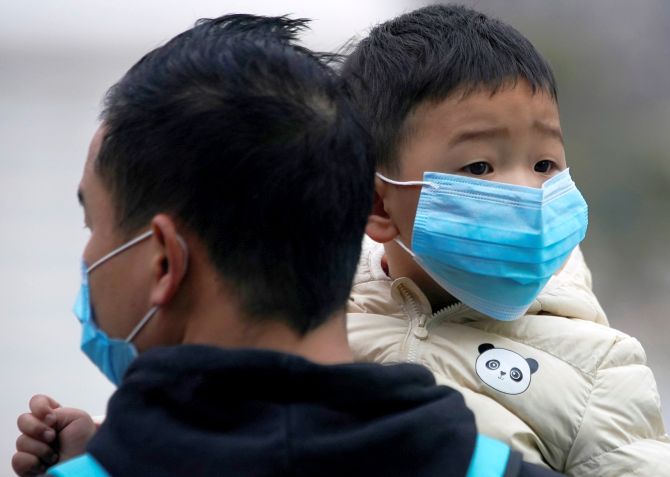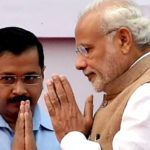The head of a hospital in China’s coronavirus-hit Wuhan city died of the epidemic amid criticism that a number of medical staff were infected due to official attempts to conceal the key findings of human-to-human transmission of the virus, as the death toll from the disease on Tuesday soared to 1,868.
IMAGE: Passengers wearing masks walk outside the Shanghai railway station in Shanghai, China. Photograph: Aly Song/Reuters
Hubei province and its capital Wuhan, from where the virus originated, continued to bear the brunt as 93 more people died on Monday while five deaths were reported from Henan, Hebei and Hunan provinces.
China’s National Health Commission on Tuesday said the death toll due to the outbreak climbed to 1,868 on Monday while the total number of confirmed cases jumped to 72,436.
A top Chinese health official said the daily death toll has come down below 100 for the first time since the virus outbreak came to light in January.
The daily number of newly confirmed cases of the novel coronavirus (COVID-19) reported across China Monday dropped to under 2,000 for the first time, Mi Feng, an official with the National Health Commission said on Tuesday.
Monday also saw the new confirmed infections of COVID-19 outside Hubei reduced to a number lower than 100 for the first time, Mi told the media..
Comparing the statistics in the peak period, Mi said the first appearance of these noteworthy decreasing numbers demonstrate that the epidemic situation is improving.
While officials claimed that the virus is stabilising, one of Wuhan’s most senior doctors has died after contracting the coronavirus.
Dr Liu Zhiming, president of Wuhan Wuchang Hospital in Hubei province died of the novel coronavirus pneumonia despite medical efforts to revive him, the state-run CCTV reported, the latest fatality among medical workers as they rush to save tens of thousands of patients at the epicenter of the outbreak.
Liu was a leading neurosurgeon in Wuhan.
Last Friday, the NHC said that a total of 1,716 medical workers had been confirmed contracting the infection. As of February 11, six medical workers were killed while treating patients. This included the whistleblower ophthalmologist, Dr Li Wenliang who was reprimanded by police for alerting about the virus over the social media in December.
Hu Bijie, a member of China’s top expert mission for medical treatment for COVID-19, told Global Times that most of the infections among medical staff occurred in the early stage of the epidemic, when people did not know the virus can be transmitted during the incubation period, and cheap and efficient test kits were not commonly used.
A postgraduate student, who requested anonymity and has interned at Wuhan-based Tongji Hospital’s infections department told the paper that the infection of medical staff was caused by carelessness in the early stage and was aggravated by a lack of medical supplies such as N95 masks, protective outfits and goggles.
China’s top epidemiologist Zhong Nanshan confirmed the people-to-people transmission on January 20.
Before that, Wuhan health authorities denied people-to-people transmissions on January 5, which analysts believe has misled residents and doctors and contributed to cross-infection, the Global Times report said.
“We missed the perfect time to curb the infection without a correct understanding of the virus and proper voice to public. The outbreak due to cross-infection then caused a severe shortage in medical resources and escalated the danger to medical staff,” the student said.
The daily’s report said infections among the medical staff is declining, especially after a range of measures were taken, such as the setting up of separate fever clinics and isolation wards, and the universal use of protective equipment.
On Monday, China has deployed over 30,000 medical staff in Wuhan. The Chinese military is also pouring its medical personnel drawn from the Army and the Air Force.
China has announced a plan to honour medical workers and other personnel who died fighting the novel coronavirus epidemic as martyrs.
Meanwhile, a study conducted by Chinese Centre for Disease Control and Prevention said “the epidemic curve of onset of symptoms” peaked around January 23-26 before declining on February 11.
The study suggests that the downward trend in the overall epidemic curve could mean that “isolation of whole cities, broadcast of critical information like hand washing and the wearing of masks and mobilisation of a multi-sector rapid response team is helping to curb the epidemic’.
The CCDC report also warned of rebound as millions of Chinese returned to cities to join work after prolonged Chinese New Year holidays.
China “needs to prepare for the possible rebound of the epidemic”, it cautioned.




